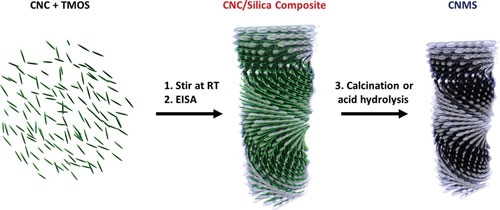| Posted: Aug 15, 2013 | |
Biopolymer templated glass with a twist |
|
| (Nanowerk Spotlight) In 2010, a team of researchers, led by Mark MacLachlan, a professor in the chemistry department at the University of British Columbia, fabricated nanoporous glass films using nanocrystals of cellulose, the main component of pulp and paper. This was the first time that the unique, helical structure of cellulose had been replicated in a mineral. This helical organization synthetically mimics the structure of the exoskeletons of some iridescent beetles. Introducing porosity into photonic crystals provides a means to tune their optical properties by infiltrating the pores with various guests: When certain liquids are added to the film, the liquid gets trapped in the pores and changes the optical properties of the films (read more: "Researchers create iridescent glass that can reflect UV or infrared light"). | |
| "In water, cellulose nanocrystals organize into a 'chiral nematic' phase, where the rod-shaped nanocrystals adopt a left-handed helical structure," MacLachlan explains to Nanowerk. "We found that adding sol-gel precursors to the preparation – e.g., Si(OMe)4 – allows us to trap the chiral nematic structure in a glass/cellulose composite. After removing the cellulose, we are left with a porous structure that has a helical organization of pores. When the pitch of the helix matches the wavelength of incident light, that wavelength of light is selectively reflected from the structure. This gives the new mesoporous silica materials photonic properties." | |
| Applications of this material could be found in energy conservation in building design – as 'smart' windows – because of its ability to reflect specific wavelengths of light, such as ultraviolet, visible or infrared. It could also be used in optical filters, chemical sensors, or as mesoporous membranes for molecule separation in the pharmaceutical industry. | |
| The group also demonstrated that cellulose nanocrystals (CNC) can be used to template a variety of different mesoporous materials with chiral nematic structures including silica, organosilica, carbon, and titania. These materials are available as free-standing, oriented films with photonic properties. More recently, they also prepared novel nanocomposite hydrogels that have long-range chiral nematic structure and photonic properties ("Responsive Photonic Hydrogels Based on Nanocrystalline Cellulose") and a new type of chiral mesoporous photonic resin ("Flexible Mesoporous Photonic Resins with Tunable Chiral Nematic Structures"). | |
 |
|
| Synthesis of chiral nematic mesoporous silica (CNMS) from cellulose nanocrystals (CNCs) and tetramethoxysilane (TMOS). (Reprinte with permission from Wiley-VCH Verlag) | |
| In a follow-up to the 2010 paper, MacLachlan's group has now conducted a comprehensive study of the preparation of chiral nematic mesoporous silica, published online on August 2, 2013, in Advanced Functional Materials ("Biopolymer Templated Glass with a Twist: Controlling the Chirality, Porosity, and Photonic Properties of Silica with Cellulose Nanocrystals"). | |
| Here, they present a detailed study on the formation of CNC/silica composite and chiral nematic mesoporous silica (CNMS) films with new results regarding the range of silica loadings that can be achieved, the influence of initial pH and aging on CNC/silica self-assembly, the thermal stability of CNMS, and how different methods of removing CNCs affect mesoporosity. | |
| "In order for these materials to ever be used in real applications, it is essential that we have an understanding of these processes and the factors that influence the film growth and their organization," says MacLachlan. "Hence, we investigated the role of pH, the mechanism of self-assembly, and the factors that affect cellulose removal. One of our findings is that the self-assembly process is very sensitive to pH and works only over a very narrow range." | |
| One very interesting application of these materials that they demonstrate in their paper is the potential to use them for new sensors. They show that the photonic structures can be used to sense very small changes in refractive index. This response could be applied to detecting glucose in blood, gases, contaminants in water, etc. | |
| The researchers note though, that developing applications of these materials remains a challenge. Scaling up the materials to industrial scale will be necessary for many applications but currently is not possible yet; but the team is working on the development of flexible photonic polymers based on cellulose nanocrystals. | |
 By
Michael
Berger
– Michael is author of three books by the Royal Society of Chemistry:
Nano-Society: Pushing the Boundaries of Technology,
Nanotechnology: The Future is Tiny, and
Nanoengineering: The Skills and Tools Making Technology Invisible
Copyright ©
Nanowerk LLC
By
Michael
Berger
– Michael is author of three books by the Royal Society of Chemistry:
Nano-Society: Pushing the Boundaries of Technology,
Nanotechnology: The Future is Tiny, and
Nanoengineering: The Skills and Tools Making Technology Invisible
Copyright ©
Nanowerk LLC
|
|
|
Become a Spotlight guest author! Join our large and growing group of guest contributors. Have you just published a scientific paper or have other exciting developments to share with the nanotechnology community? Here is how to publish on nanowerk.com. |
|
